engine FORD TRANSIT CONNECT 2014 2.G Workshop Manual
[x] Cancel search | Manufacturer: FORD, Model Year: 2014, Model line: TRANSIT CONNECT, Model: FORD TRANSIT CONNECT 2014 2.GPages: 411, PDF Size: 6.62 MB
Page 170 of 411
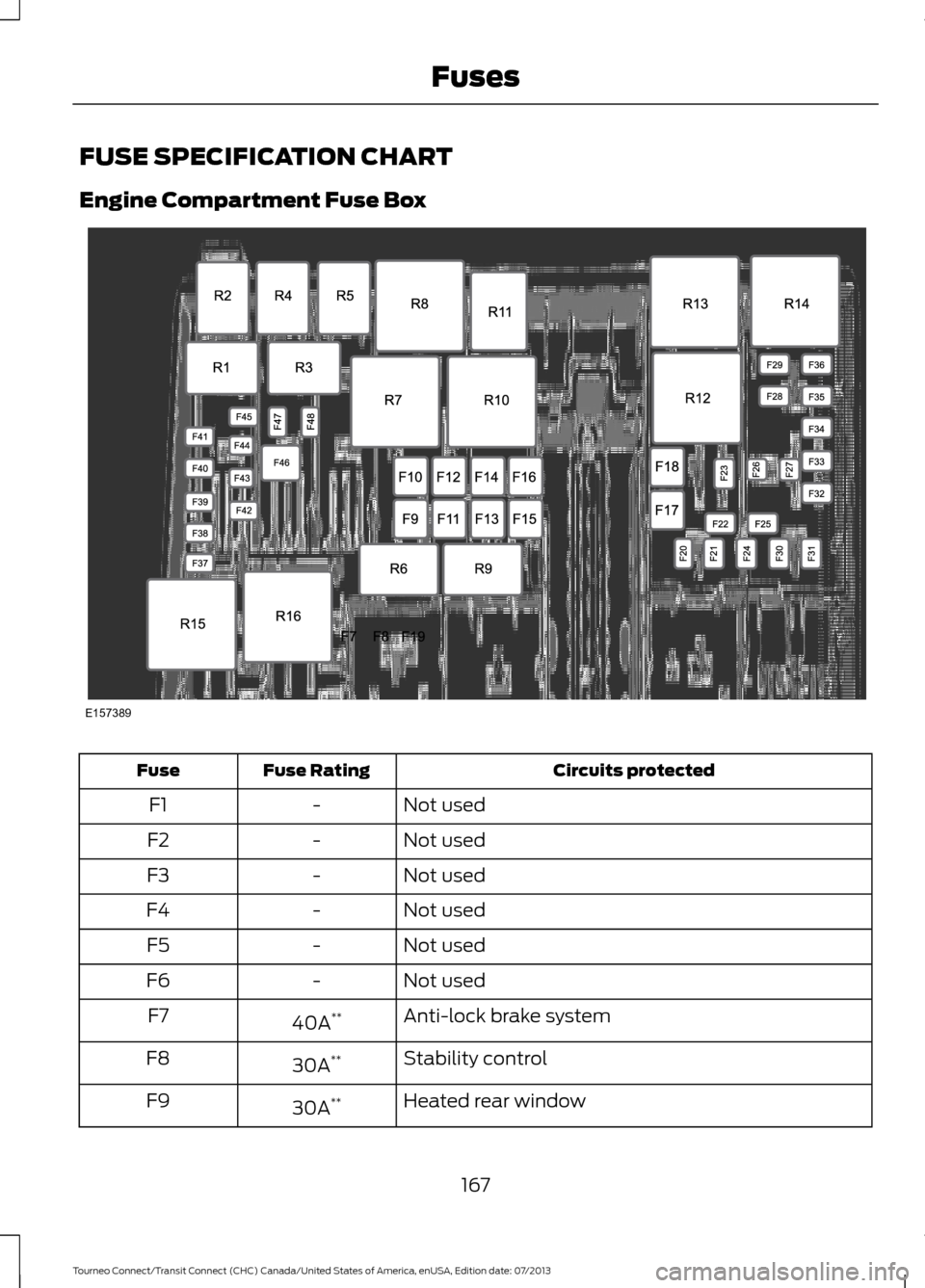
FUSE SPECIFICATION CHART
Engine Compartment Fuse Box
Circuits protected
Fuse Rating
Fuse
Not used
-
F1
Not used
-
F2
Not used
-
F3
Not used
-
F4
Not used
-
F5
Not used
-
F6
Anti-lock brake system
40A **
F7
Stability control
30A **
F8
Heated rear window
30A **
F9
167
Tourneo Connect/Transit Connect (CHC) Canada/United States of America, enUSA, Edition date: 07/2013 FusesE157389
Page 171 of 411
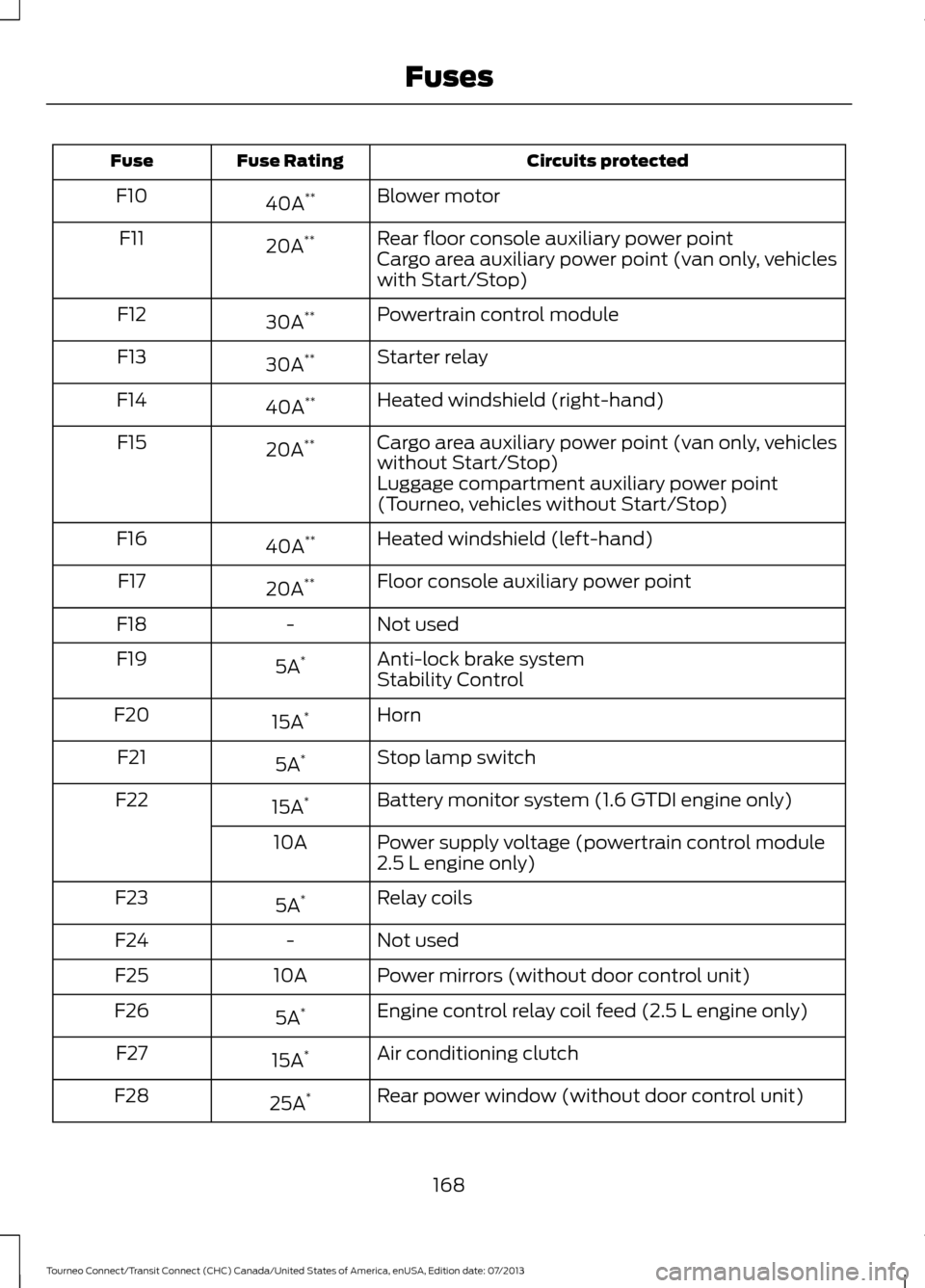
Circuits protected
Fuse Rating
Fuse
Blower motor
40A **
F10
Rear floor console auxiliary power point
20A **
F11
Cargo area auxiliary power point (van only, vehicles
with Start/Stop)
Powertrain control module
30A **
F12
Starter relay
30A **
F13
Heated windshield (right-hand)
40A **
F14
Cargo area auxiliary power point (van only, vehicles
without Start/Stop)
20A
**
F15
Luggage compartment auxiliary power point
(Tourneo, vehicles without Start/Stop)
Heated windshield (left-hand)
40A **
F16
Floor console auxiliary power point
20A **
F17
Not used
-
F18
Anti-lock brake system
5A *
F19
Stability Control
Horn
15A *
F20
Stop lamp switch
5A *
F21
Battery monitor system (1.6 GTDI engine only)
15A *
F22
Power supply voltage (powertrain control module
2.5 L engine only)
10A
Relay coils
5A *
F23
Not used
-
F24
Power mirrors (without door control unit)
10A
F25
Engine control relay coil feed (2.5 L engine only)
5A *
F26
Air conditioning clutch
15A *
F27
Rear power window (without door control unit)
25A *
F28
168
Tourneo Connect/Transit Connect (CHC) Canada/United States of America, enUSA, Edition date: 07/2013 Fuses
Page 172 of 411
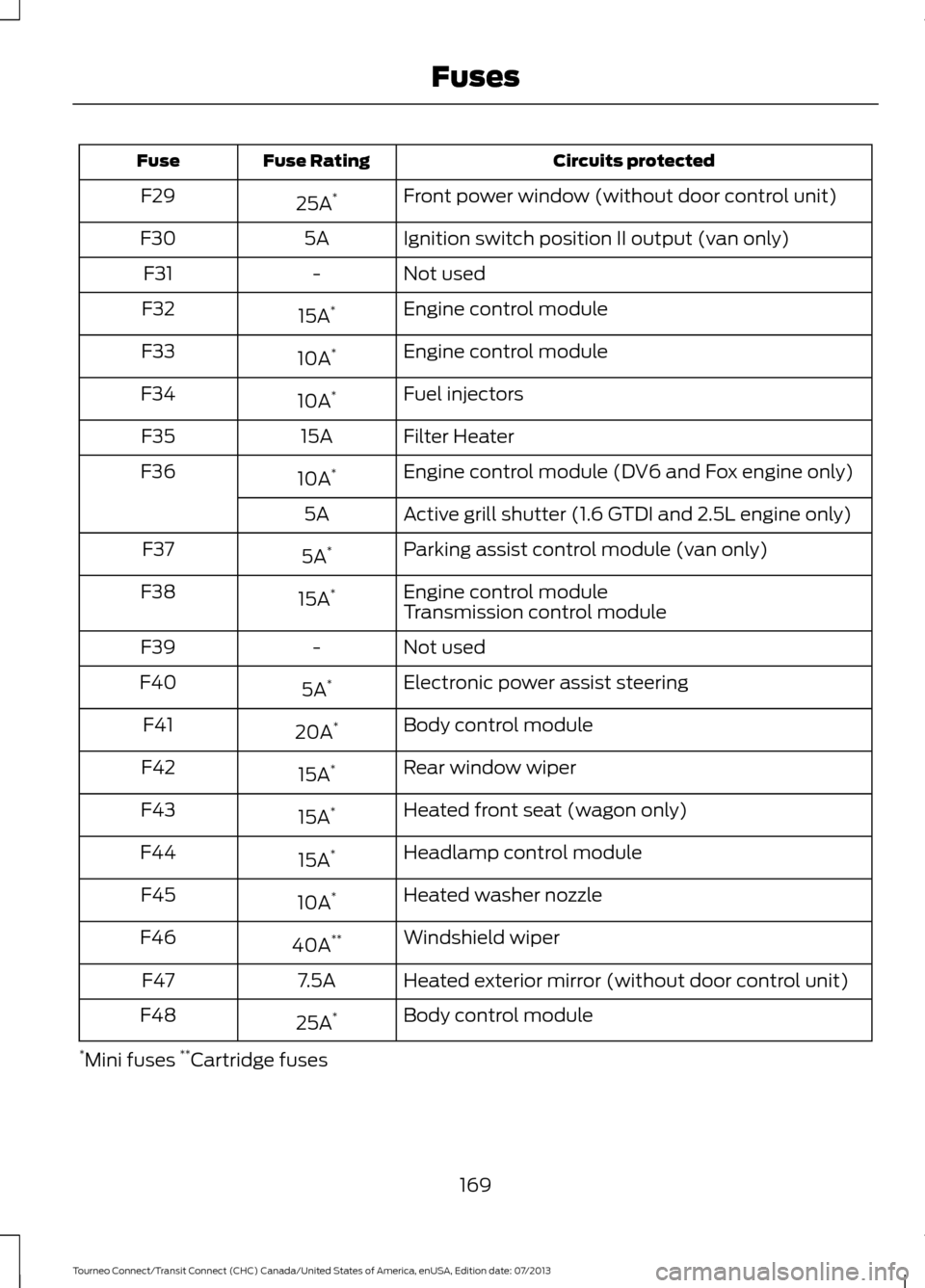
Circuits protected
Fuse Rating
Fuse
Front power window (without door control unit)
25A *
F29
Ignition switch position II output (van only)
5A
F30
Not used
-
F31
Engine control module
15A *
F32
Engine control module
10A *
F33
Fuel injectors
10A *
F34
Filter Heater
15A
F35
Engine control module (DV6 and Fox engine only)
10A *
F36
Active grill shutter (1.6 GTDI and 2.5L engine only)
5A
Parking assist control module (van only)
5A *
F37
Engine control module
15A *
F38
Transmission control module
Not used
-
F39
Electronic power assist steering
5A *
F40
Body control module
20A *
F41
Rear window wiper
15A *
F42
Heated front seat (wagon only)
15A *
F43
Headlamp control module
15A *
F44
Heated washer nozzle
10A *
F45
Windshield wiper
40A **
F46
Heated exterior mirror (without door control unit)
7.5A
F47
Body control module
25A *
F48
* Mini fuses **
Cartridge fuses
169
Tourneo Connect/Transit Connect (CHC) Canada/United States of America, enUSA, Edition date: 07/2013 Fuses
Page 173 of 411
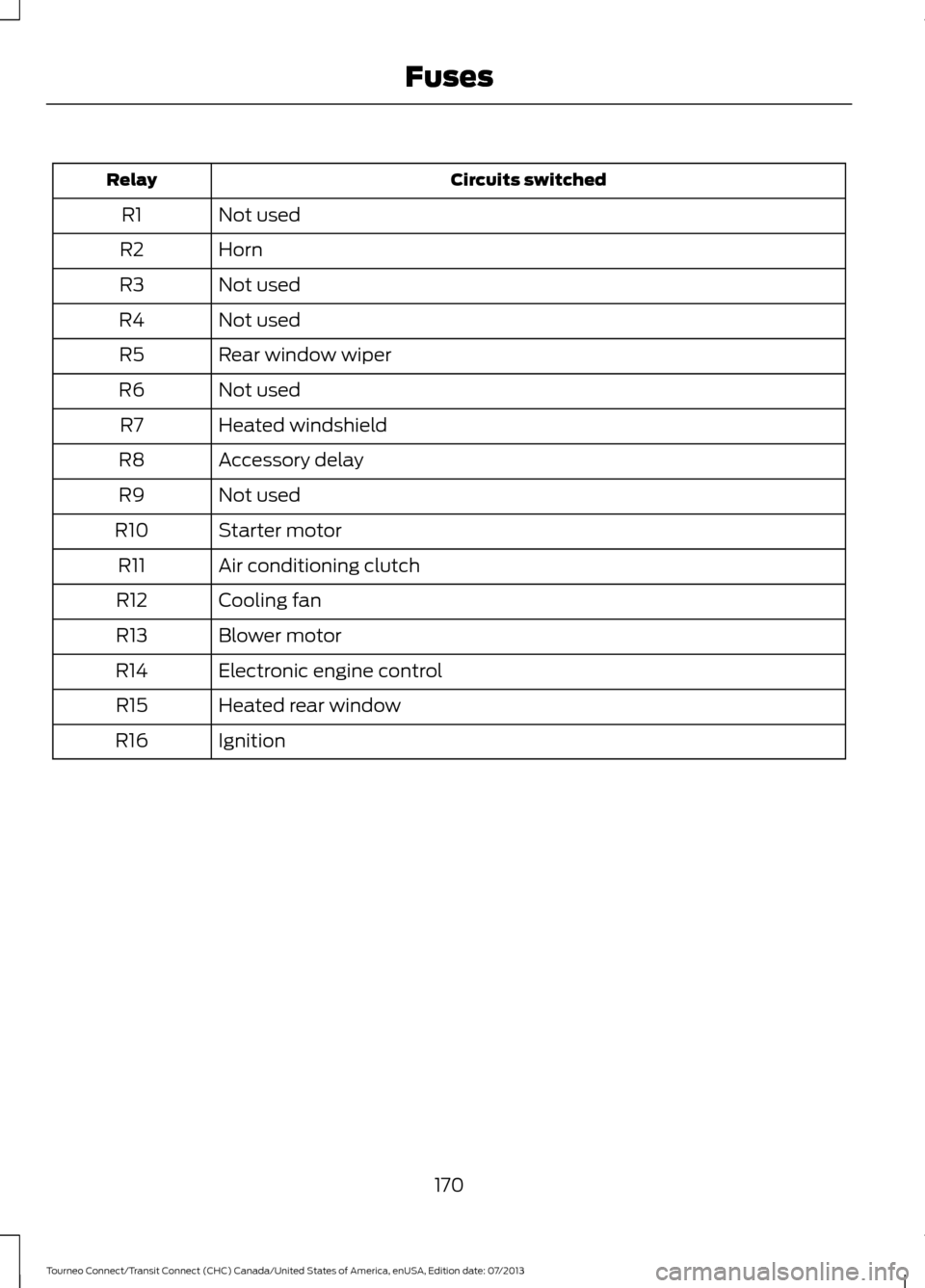
Circuits switched
Relay
Not used
R1
Horn
R2
Not used
R3
Not used
R4
Rear window wiper
R5
Not used
R6
Heated windshield
R7
Accessory delay
R8
Not used
R9
Starter motor
R10
Air conditioning clutch
R11
Cooling fan
R12
Blower motor
R13
Electronic engine control
R14
Heated rear window
R15
Ignition
R16
170
Tourneo Connect/Transit Connect (CHC) Canada/United States of America, enUSA, Edition date: 07/2013 Fuses
Page 180 of 411
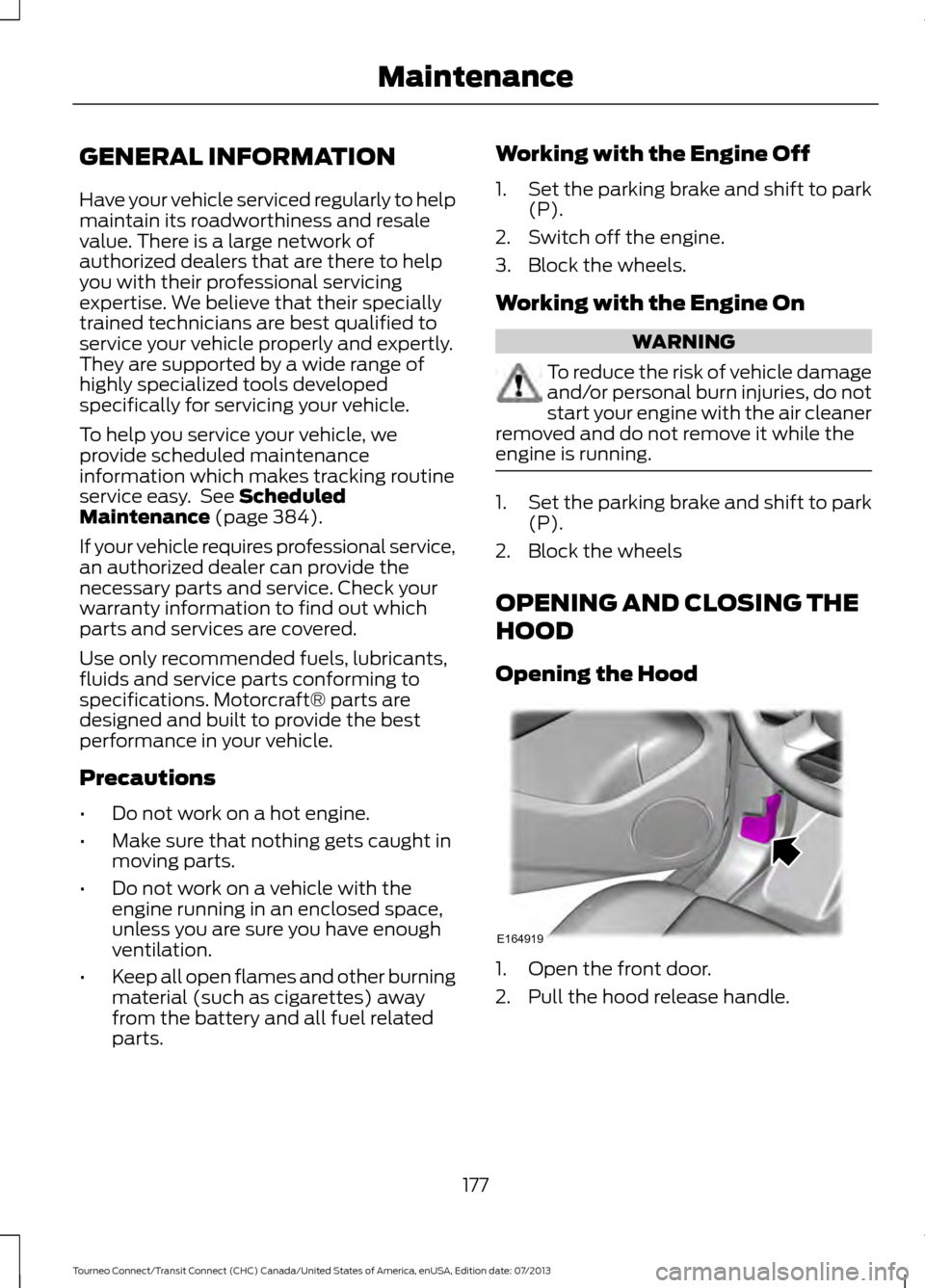
GENERAL INFORMATION
Have your vehicle serviced regularly to help
maintain its roadworthiness and resale
value. There is a large network of
authorized dealers that are there to help
you with their professional servicing
expertise. We believe that their specially
trained technicians are best qualified to
service your vehicle properly and expertly.
They are supported by a wide range of
highly specialized tools developed
specifically for servicing your vehicle.
To help you service your vehicle, we
provide scheduled maintenance
information which makes tracking routine
service easy. See Scheduled
Maintenance (page 384).
If your vehicle requires professional service,
an authorized dealer can provide the
necessary parts and service. Check your
warranty information to find out which
parts and services are covered.
Use only recommended fuels, lubricants,
fluids and service parts conforming to
specifications. Motorcraft® parts are
designed and built to provide the best
performance in your vehicle.
Precautions
• Do not work on a hot engine.
• Make sure that nothing gets caught in
moving parts.
• Do not work on a vehicle with the
engine running in an enclosed space,
unless you are sure you have enough
ventilation.
• Keep all open flames and other burning
material (such as cigarettes) away
from the battery and all fuel related
parts. Working with the Engine Off
1.
Set the parking brake and shift to park
(P).
2. Switch off the engine.
3. Block the wheels.
Working with the Engine On WARNING
To reduce the risk of vehicle damage
and/or personal burn injuries, do not
start your engine with the air cleaner
removed and do not remove it while the
engine is running. 1.
Set the parking brake and shift to park
(P).
2. Block the wheels
OPENING AND CLOSING THE
HOOD
Opening the Hood 1. Open the front door.
2. Pull the hood release handle.
177
Tourneo Connect/Transit Connect (CHC) Canada/United States of America, enUSA, Edition date: 07/2013 MaintenanceE164919
Page 182 of 411
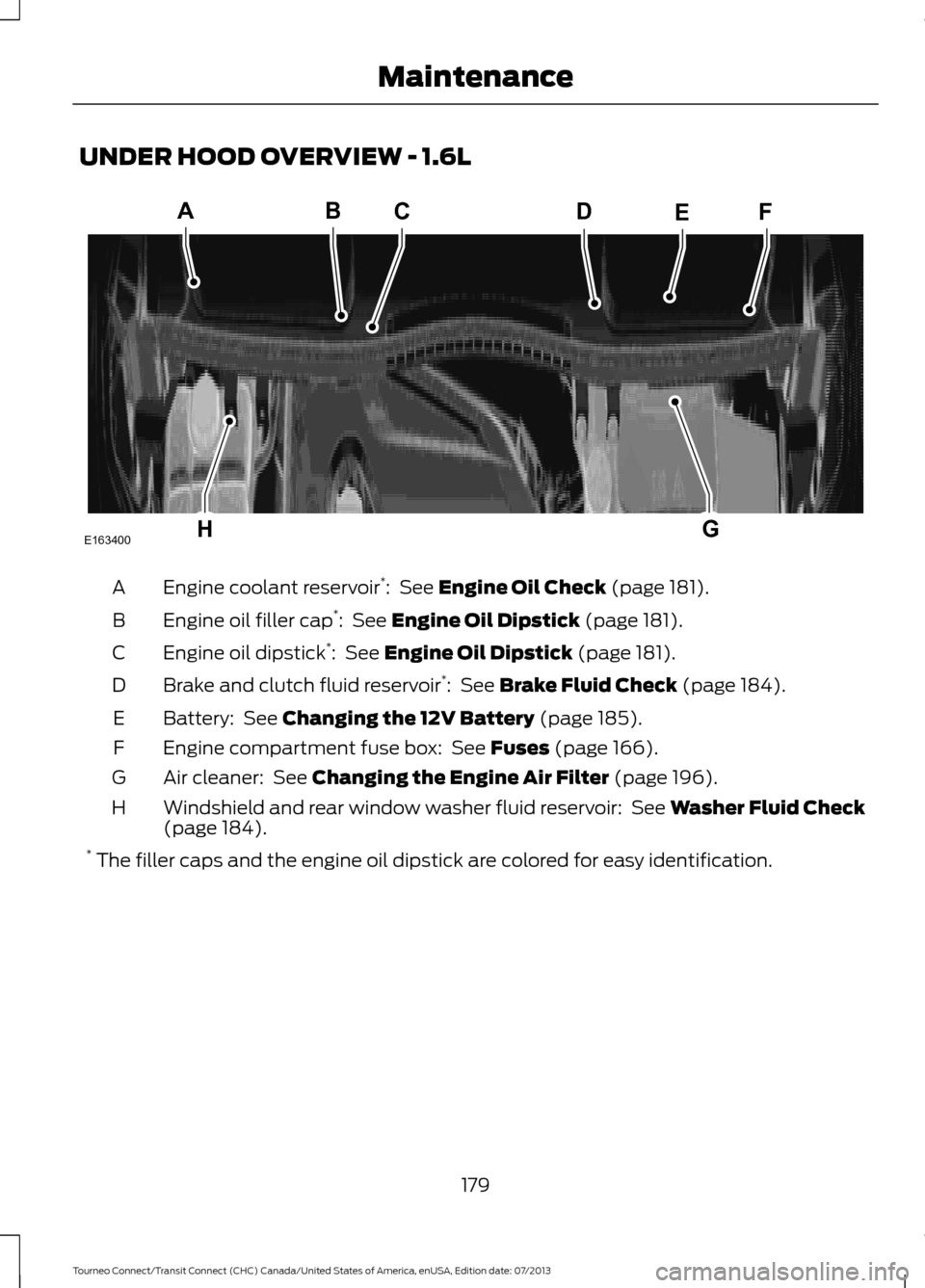
UNDER HOOD OVERVIEW - 1.6L
Engine coolant reservoir
*
: See Engine Oil Check (page 181).
A
Engine oil filler cap *
:
See Engine Oil Dipstick (page 181).
B
Engine oil dipstick *
:
See Engine Oil Dipstick (page 181).
C
Brake and clutch fluid reservoir *
:
See Brake Fluid Check (page 184).
D
Battery:
See Changing the 12V Battery (page 185).
E
Engine compartment fuse box:
See Fuses (page 166).
F
Air cleaner:
See Changing the Engine Air Filter (page 196).
G
Windshield and rear window washer fluid reservoir:
See Washer Fluid Check
(page 184).
H
* The filler caps and the engine oil dipstick are colored for easy identification.
179
Tourneo Connect/Transit Connect (CHC) Canada/United States of America, enUSA, Edition date: 07/2013 MaintenanceA
HG
DBCEF
E163400
Page 183 of 411
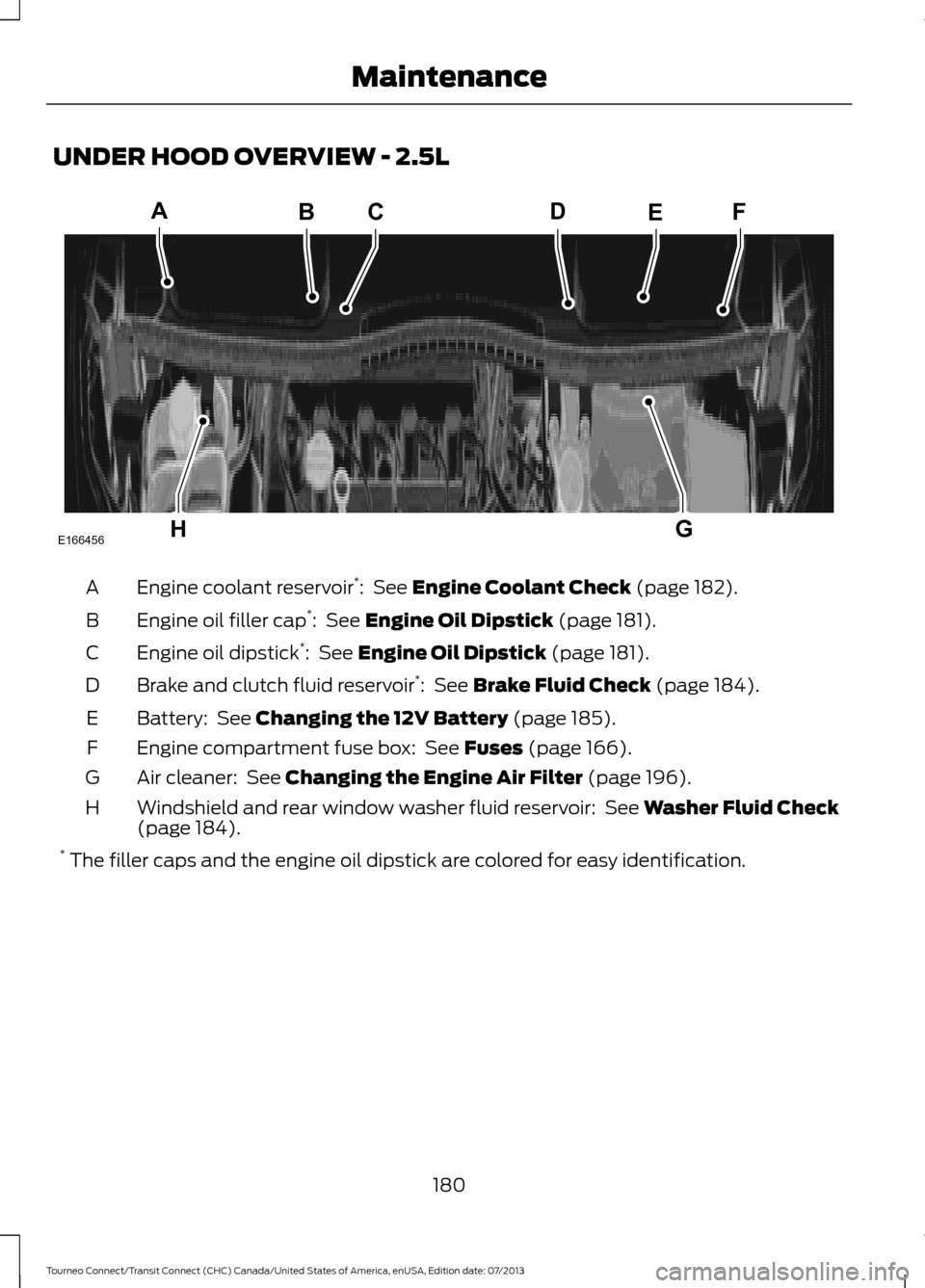
UNDER HOOD OVERVIEW - 2.5L
Engine coolant reservoir
*
: See Engine Coolant Check (page 182).
A
Engine oil filler cap *
:
See Engine Oil Dipstick (page 181).
B
Engine oil dipstick *
:
See Engine Oil Dipstick (page 181).
C
Brake and clutch fluid reservoir *
:
See Brake Fluid Check (page 184).
D
Battery:
See Changing the 12V Battery (page 185).
E
Engine compartment fuse box:
See Fuses (page 166).
F
Air cleaner:
See Changing the Engine Air Filter (page 196).
G
Windshield and rear window washer fluid reservoir:
See Washer Fluid Check
(page 184).
H
* The filler caps and the engine oil dipstick are colored for easy identification.
180
Tourneo Connect/Transit Connect (CHC) Canada/United States of America, enUSA, Edition date: 07/2013 MaintenanceBCA
HG
DEF
E166456
Page 184 of 411
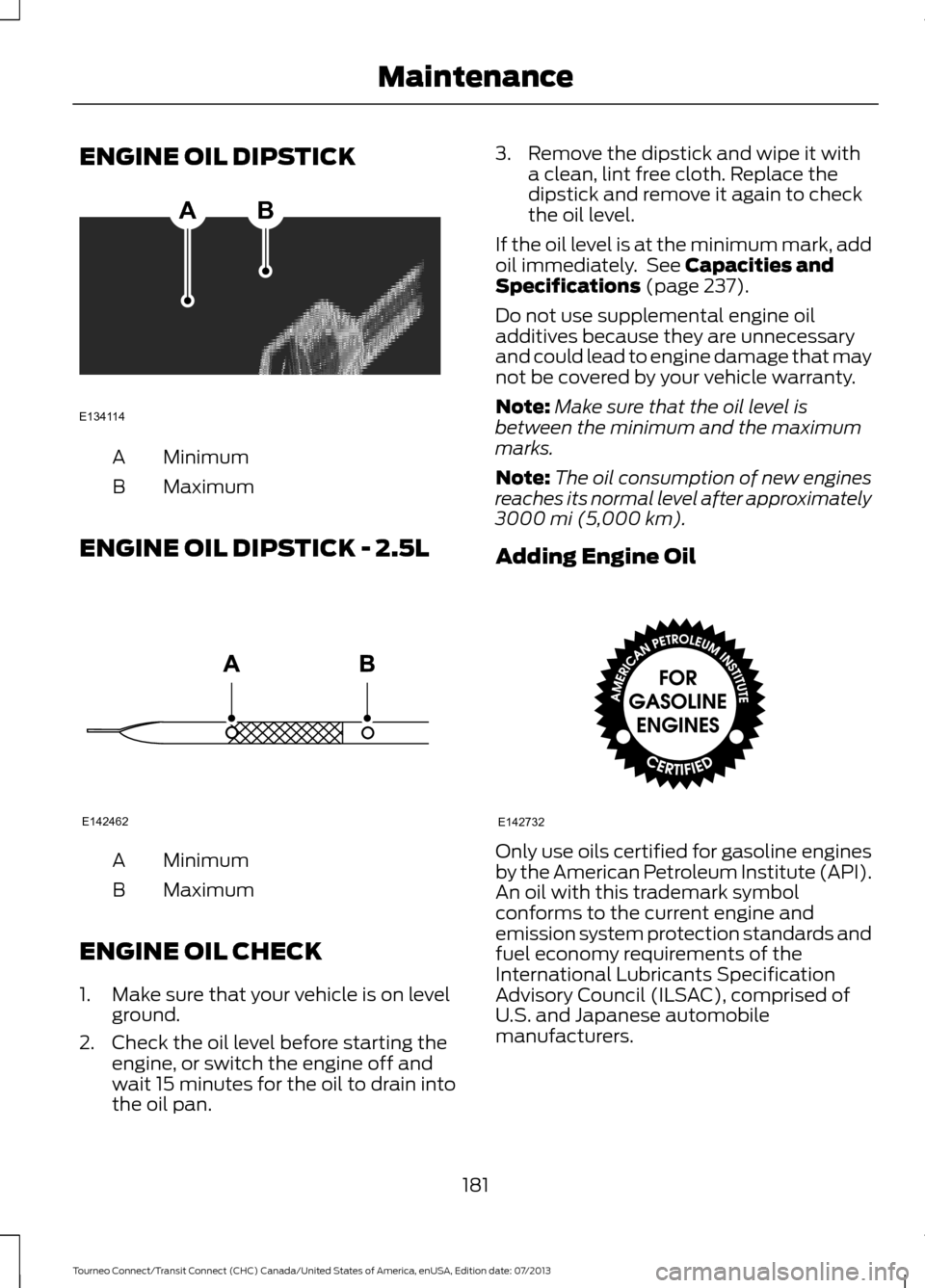
ENGINE OIL DIPSTICK
Minimum
A
Maximum
B
ENGINE OIL DIPSTICK - 2.5L Minimum
A
Maximum
B
ENGINE OIL CHECK
1. Make sure that your vehicle is on level ground.
2. Check the oil level before starting the engine, or switch the engine off and
wait 15 minutes for the oil to drain into
the oil pan. 3. Remove the dipstick and wipe it with
a clean, lint free cloth. Replace the
dipstick and remove it again to check
the oil level.
If the oil level is at the minimum mark, add
oil immediately. See Capacities and
Specifications (page 237).
Do not use supplemental engine oil
additives because they are unnecessary
and could lead to engine damage that may
not be covered by your vehicle warranty.
Note: Make sure that the oil level is
between the minimum and the maximum
marks.
Note: The oil consumption of new engines
reaches its normal level after approximately
3000 mi (5,000 km)
.
Adding Engine Oil Only use oils certified for gasoline engines
by the American Petroleum Institute (API).
An oil with this trademark symbol
conforms to the current engine and
emission system protection standards and
fuel economy requirements of the
International Lubricants Specification
Advisory Council (ILSAC), comprised of
U.S. and Japanese automobile
manufacturers.
181
Tourneo Connect/Transit Connect (CHC) Canada/United States of America, enUSA, Edition date: 07/2013 MaintenanceAB
E134114 E142462 E142732
Page 185 of 411
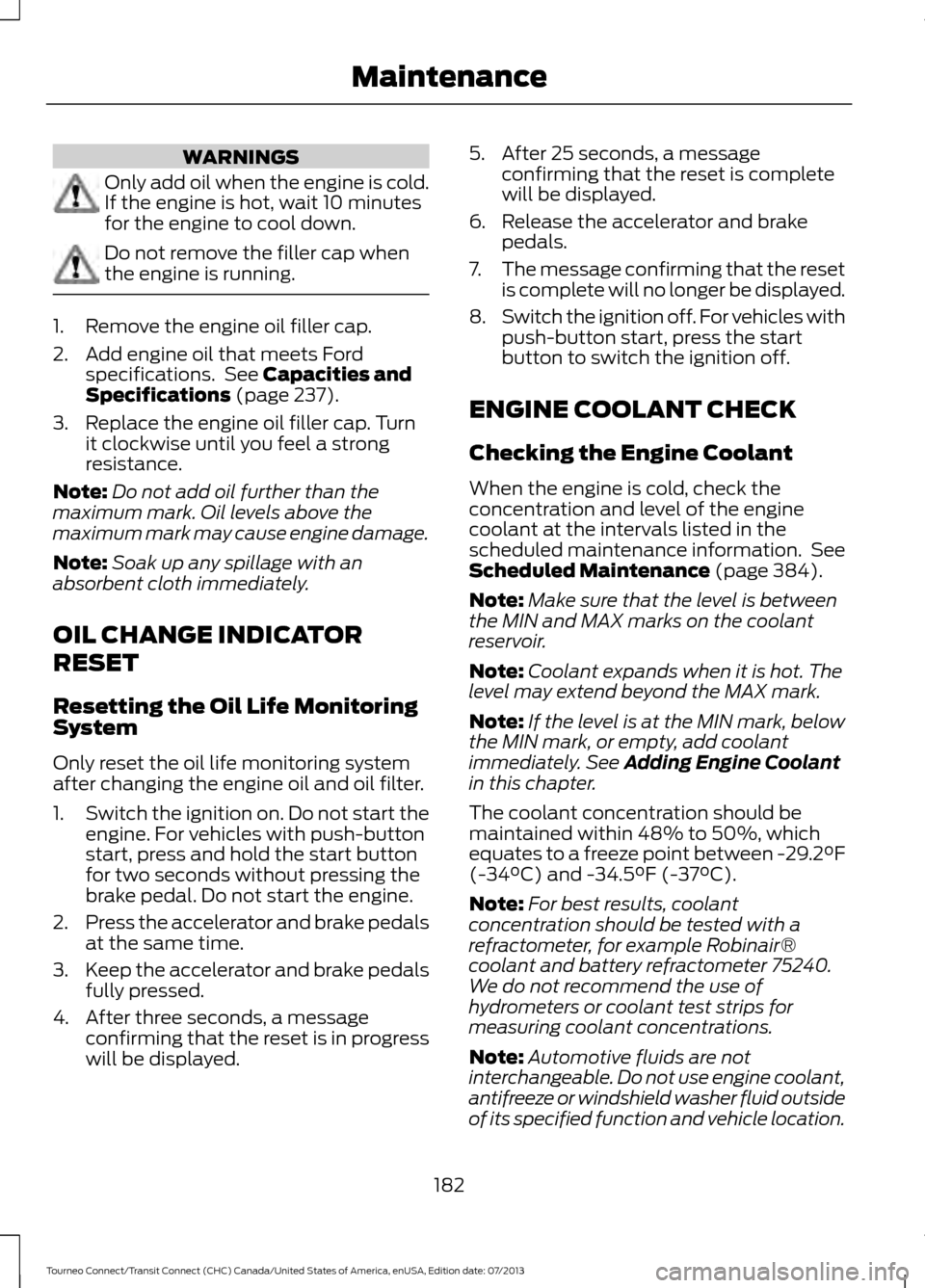
WARNINGS
Only add oil when the engine is cold.
If the engine is hot, wait 10 minutes
for the engine to cool down.
Do not remove the filler cap when
the engine is running.
1. Remove the engine oil filler cap.
2. Add engine oil that meets Ford
specifications. See Capacities and
Specifications (page 237).
3. Replace the engine oil filler cap. Turn it clockwise until you feel a strong
resistance.
Note: Do not add oil further than the
maximum mark. Oil levels above the
maximum mark may cause engine damage.
Note: Soak up any spillage with an
absorbent cloth immediately.
OIL CHANGE INDICATOR
RESET
Resetting the Oil Life Monitoring
System
Only reset the oil life monitoring system
after changing the engine oil and oil filter.
1. Switch the ignition on. Do not start the
engine. For vehicles with push-button
start, press and hold the start button
for two seconds without pressing the
brake pedal. Do not start the engine.
2. Press the accelerator and brake pedals
at the same time.
3. Keep the accelerator and brake pedals
fully pressed.
4. After three seconds, a message confirming that the reset is in progress
will be displayed. 5. After 25 seconds, a message
confirming that the reset is complete
will be displayed.
6. Release the accelerator and brake pedals.
7. The message confirming that the reset
is complete will no longer be displayed.
8. Switch the ignition off. For vehicles with
push-button start, press the start
button to switch the ignition off.
ENGINE COOLANT CHECK
Checking the Engine Coolant
When the engine is cold, check the
concentration and level of the engine
coolant at the intervals listed in the
scheduled maintenance information. See
Scheduled Maintenance
(page 384).
Note: Make sure that the level is between
the MIN and MAX marks on the coolant
reservoir.
Note: Coolant expands when it is hot. The
level may extend beyond the MAX mark.
Note: If the level is at the MIN mark, below
the MIN mark, or empty, add coolant
immediately. See
Adding Engine Coolant
in this chapter.
The coolant concentration should be
maintained within 48% to 50%, which
equates to a freeze point between -29.2°F
(-34°C)
and -34.5°F (-37°C).
Note: For best results, coolant
concentration should be tested with a
refractometer, for example Robinair®
coolant and battery refractometer 75240.
We do not recommend the use of
hydrometers or coolant test strips for
measuring coolant concentrations.
Note: Automotive fluids are not
interchangeable. Do not use engine coolant,
antifreeze or windshield washer fluid outside
of its specified function and vehicle location.
182
Tourneo Connect/Transit Connect (CHC) Canada/United States of America, enUSA, Edition date: 07/2013 Maintenance
Page 186 of 411
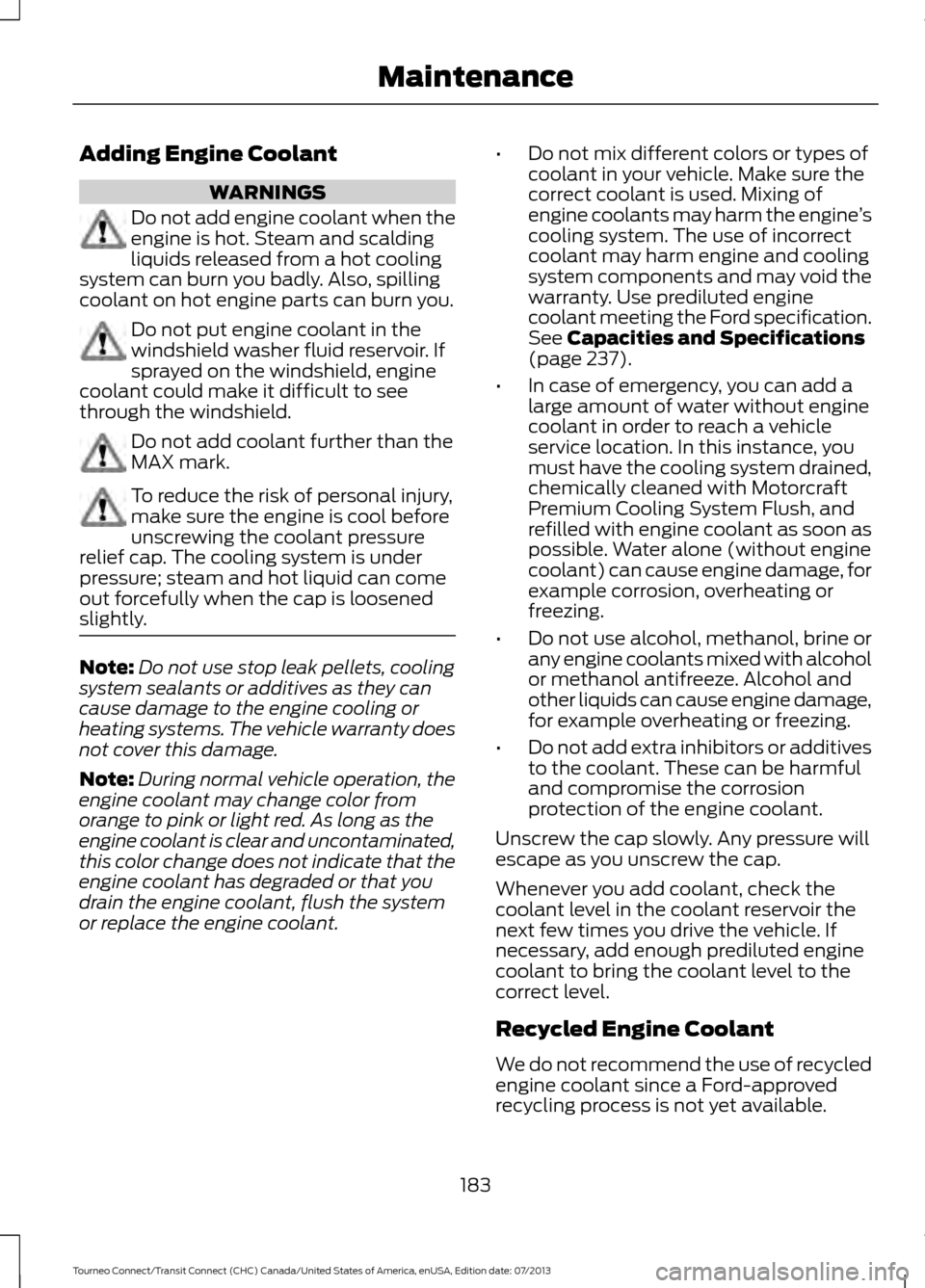
Adding Engine Coolant
WARNINGS
Do not add engine coolant when the
engine is hot. Steam and scalding
liquids released from a hot cooling
system can burn you badly. Also, spilling
coolant on hot engine parts can burn you. Do not put engine coolant in the
windshield washer fluid reservoir. If
sprayed on the windshield, engine
coolant could make it difficult to see
through the windshield. Do not add coolant further than the
MAX mark.
To reduce the risk of personal injury,
make sure the engine is cool before
unscrewing the coolant pressure
relief cap. The cooling system is under
pressure; steam and hot liquid can come
out forcefully when the cap is loosened
slightly. Note:
Do not use stop leak pellets, cooling
system sealants or additives as they can
cause damage to the engine cooling or
heating systems. The vehicle warranty does
not cover this damage.
Note: During normal vehicle operation, the
engine coolant may change color from
orange to pink or light red. As long as the
engine coolant is clear and uncontaminated,
this color change does not indicate that the
engine coolant has degraded or that you
drain the engine coolant, flush the system
or replace the engine coolant. •
Do not mix different colors or types of
coolant in your vehicle. Make sure the
correct coolant is used. Mixing of
engine coolants may harm the engine ’s
cooling system. The use of incorrect
coolant may harm engine and cooling
system components and may void the
warranty. Use prediluted engine
coolant meeting the Ford specification.
See Capacities and Specifications
(page 237).
• In case of emergency, you can add a
large amount of water without engine
coolant in order to reach a vehicle
service location. In this instance, you
must have the cooling system drained,
chemically cleaned with Motorcraft
Premium Cooling System Flush, and
refilled with engine coolant as soon as
possible. Water alone (without engine
coolant) can cause engine damage, for
example corrosion, overheating or
freezing.
• Do not use alcohol, methanol, brine or
any engine coolants mixed with alcohol
or methanol antifreeze. Alcohol and
other liquids can cause engine damage,
for example overheating or freezing.
• Do not add extra inhibitors or additives
to the coolant. These can be harmful
and compromise the corrosion
protection of the engine coolant.
Unscrew the cap slowly. Any pressure will
escape as you unscrew the cap.
Whenever you add coolant, check the
coolant level in the coolant reservoir the
next few times you drive the vehicle. If
necessary, add enough prediluted engine
coolant to bring the coolant level to the
correct level.
Recycled Engine Coolant
We do not recommend the use of recycled
engine coolant since a Ford-approved
recycling process is not yet available.
183
Tourneo Connect/Transit Connect (CHC) Canada/United States of America, enUSA, Edition date: 07/2013 Maintenance